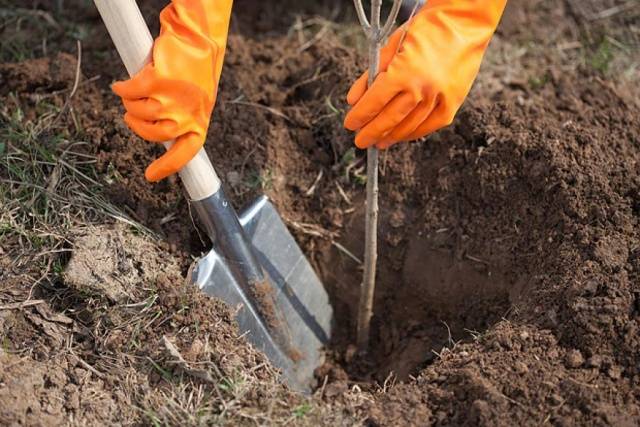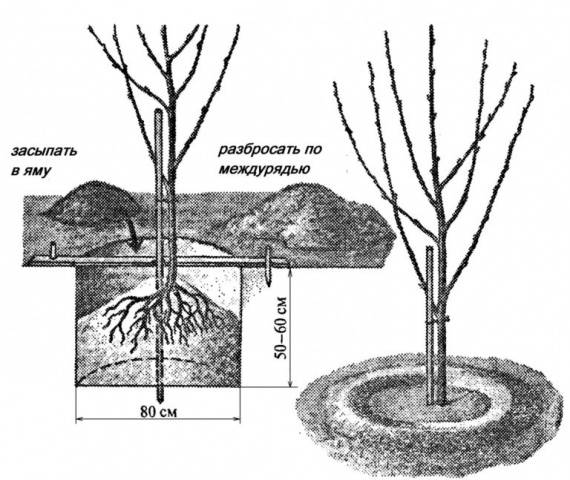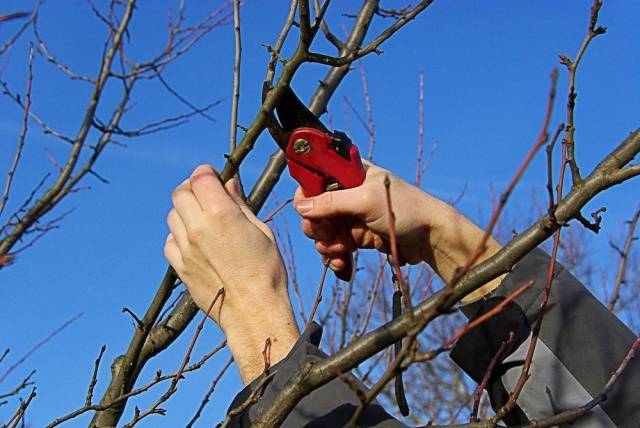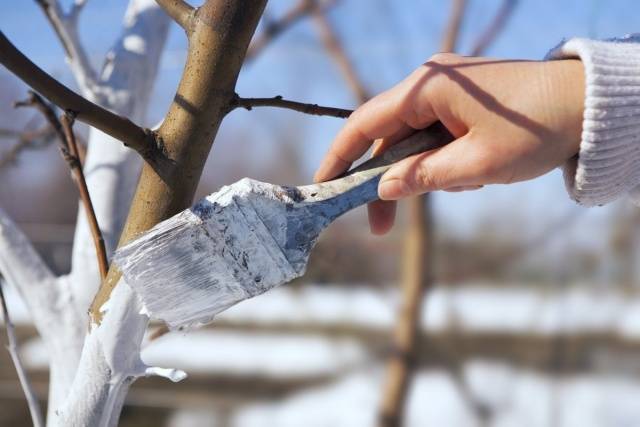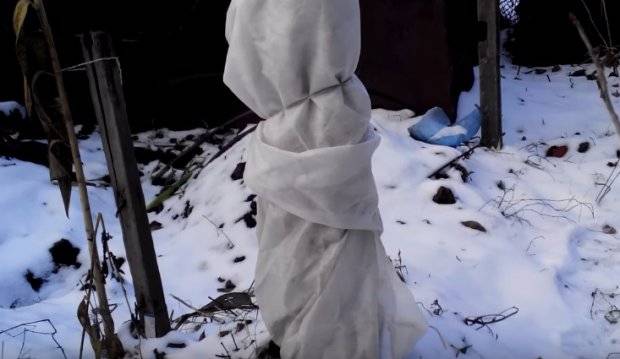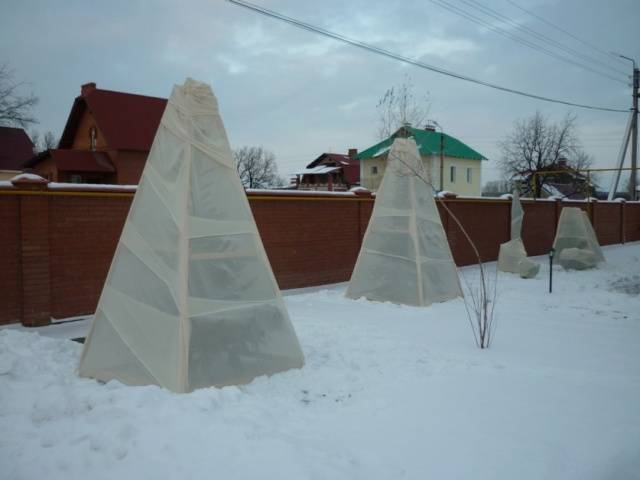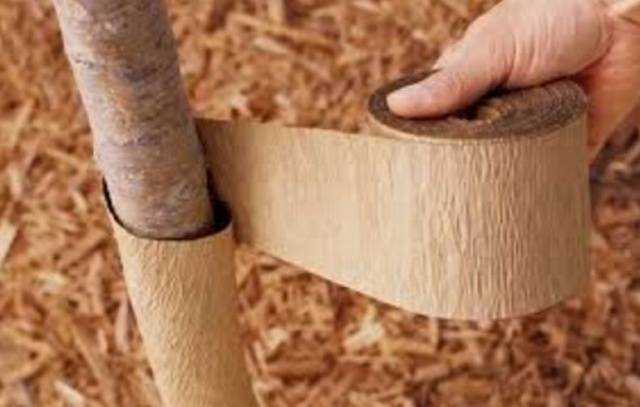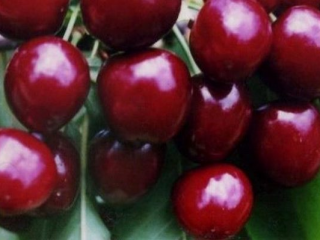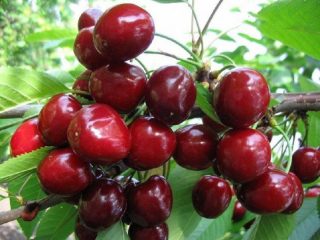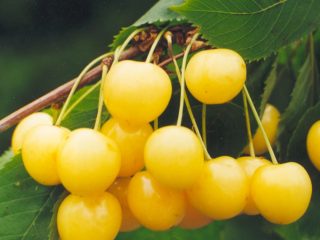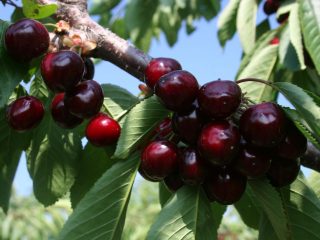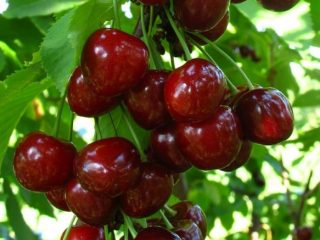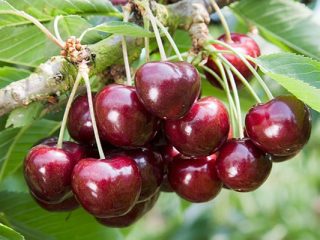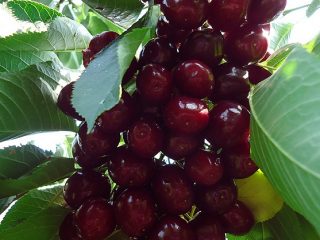Content
- 1 Rules for caring for cherries in the fall, preparing for winter
- 2 Planting cherries in autumn
- 3 How to properly prune cherries in the fall
- 4 Caring for cherries in autumn
- 5 How to insulate cherries for the winter
- 6 The nuances of preparing cherries for winter in different regions
- 7 When to remove cover from cherries in spring
- 8 Conclusion
Planting and caring for cherries in the fall are included in the year-round complex of work and are their integral part. They are no less important than, for example, spraying against pests or pruning. Only regular performance of all seasonal work on caring for cherries can guarantee a good harvest.
And autumn work is doubly important, because it depends on them how the plant will overwinter, what reserve of strength it will receive and how early it will enter the growing season next year. It is in the fall that the foundations of the future harvest are laid.
Rules for caring for cherries in the fall, preparing for winter
Autumn is not a reason for a gardener to rest and relax. There are still many warm sunny days after harvest, and you need to try to use them as efficiently as possible. And there really is a lot that needs to be done.
The importance of autumn cherry care
Not only the future harvest, but also the life of the tree itself directly depends on how completely and efficiently the autumn work is carried out. After all, winter is ahead - the most difficult period for any plant, and even more so for one like cherries. During fruiting, and especially abundant fruiting, the tree spends a lot of energy, so after harvesting it is severely depleted. During the short autumn period, he needs to restore his energy reserve as much as possible in order to go into hibernation, like a fully charged battery. This will allow the tree to overwinter well and begin the growing season calmly in the spring.
If the plant does not have time to prepare for winter, does not have time to gain strength, winter will deplete it even more or kill it completely. In spring, such plants begin to grow late, are late in flowering, or do not bloom at all. Therefore, the gardener’s task is to do everything to help the cherries “recharge” as quickly and fully as possible before the winter cold.
What work will gardeners have to do in the fall?
The range of autumn work for caring for cherries is quite extensive. The following activities must be carried out:
- sanitary pruning;
- whitewashing of trunks;
- cleaning, weeding and loosening of the tree trunk circle;
- moisture-charging irrigation;
- fertilizing
In addition, some varieties are covered for the winter.
It is also worth noting that the most important part of the work is carried out in the fall - planting young cherry seedlings. This is done mainly in the southern regions - in more northern regions, seedlings are planted in the spring.
Planting cherries in autumn
In regions with mild winters, autumn planting of young seedlings is considered the main one. This is due to the fact that before the onset of cold weather, the tree has time to take root well and endure the winter without problems. Where winter begins early, there is not enough time for the seedling to adapt, and the plant may die.
When is it better to plant cherries: autumn or spring
Spring planting has a number of advantages. This is especially true in regions with cool climates. With this planting option, a plant planted in the spring has enough time to be guaranteed to take root and face the winter cold without problems.
In hot regions, on the contrary, high temperatures create problems. In this case, the plant planted in spring will constantly suffer from high temperatures, sunburn and lack of moisture.In autumn, all these harmful factors are absent.
When can you plant cherries in the fall?
Cherries need to be planted several weeks before the onset of permanent frosts. The timing will greatly depend on the region, but on average this is the period from the last ten days of September to the end of the second ten days of October. In the Moscow region, Central regions and Southern Siberia, it is better to focus on the end of September; in more southern regions this can be done later.
Choosing a place to plant cherries
Most cherry varieties are self-sterile. Such plants definitely need a pollinator to set fruit. Therefore, seedlings are usually planted in a group of several trees. The only exception can be a situation when a young plant is added to existing adults or pollinators grow in close proximity, for example, behind a fence.
Sweet cherries tolerate frosts well (especially its winter-hardy varieties), but they really do not like cold winds. You should avoid planting it on the north side of the site. It needs sunlight and water to grow well. At the same time, excess moisture is also harmful, so places with periodic flooding or high groundwater levels should be avoided.
This plant grows well on light loamy and sandy loam soils with neutral acidity. Heavy clay areas are not suitable for planting it.
How to choose the right cherry seedling for planting
Cherry trees are planted as seedlings of the second year of life, less often as annuals. When choosing planting material, you need to pay attention to the following:
- The seedling must have a clearly visible grafting site in the lower part of the trunk. At the junction of the rootstock and scion, the difference in trunk thickness is necessarily visible.If there are no traces of grafting, then the plant was grown from a seed (this is a seedling). In this case, there is a high probability that all varietal characteristics will not be preserved and a non-varietal plant will grow from the seedling.
- The seedling must have a well-developed main trunk (conductor) and lateral branches. This will allow you to correctly form the crown of the future tree.
- The root system should be well developed: have 2-3 main roots and many small ones. There should be no rotten or dry roots among them.
Cherry planting scheme
Cherry seedlings can be planted in a row, in a checkerboard pattern or in a random pattern. It is important to maintain the distance between neighboring plantings; it should be at least 3 m. The trees should be located at the same distance from the walls of houses, outbuildings or blank high fences.
How to plant cherries in the fall
- Planting holes for planting cherries in the fall need to be prepared 1.5–2 months before the planned planting date.
- The holes are dug to a depth of approximately 0.8 m, their diameter is 0.6–0.7 m.
- The removed soil is mixed with several buckets of humus and 0.2 kg of superphosphate. During the time that will pass before planting, the soil on the walls and bottom of the pit will have time to become saturated with air, and the excavated soil will turn into a nutrient mixture with which the young seedling will be covered.
- Before planting, a stake is driven into the bottom of the hole - a support to which the planted tree will be tied.
- An earthen mound is placed at the bottom of the pit.
- A seedling is placed on its top, and the root collar should be flush with the ground.
- The roots are covered with nutritious soil, compacting it slightly to prevent the formation of voids.
- After falling asleep, an earthen roller is formed around the seedling, limiting the trunk circle. It will prevent water from spreading when watering.
- You need to pour 3 buckets of water under each tree, and then mulch the soil with sawdust or peat.
What can be planted next to cherries?
Cherry is a fairly strong antagonist and does not tolerate proximity to other trees or shrubs if they are very close. Another cherry or its closest relative, the cherry, will feel best next to it. Other trees will simply interfere with cross-pollination.
Among other crops, grapes get along well with it. Black elderberry also feels good nearby, so many gardeners plant it specifically as protection against aphids. Flowers grow quietly in the root zone: nasturtiums, primroses, tulips. But you should not plant berry bushes, since the powerful root system of the cherry tree will simply choke them.
How to properly prune cherries in the fall
Pruning is an important part of caring for cherries. Proper pruning can extend the life of a tree, significantly increase the quantity and quality of the harvest, and also rid the plant of dry, broken and diseased branches.
The importance of pruning cherries in the fall
Autumn sanitary pruning helps the tree get rid of old, diseased and dry branches. In addition, shoots that do not bear fruit are removed. Therefore, the tree retains more strength for the development of fruiting plants.
When to prune cherries: autumn or spring
Sanitary pruning is carried out twice per season: in autumn and spring. All other types of pruning - in the spring, before the sap begins to flow.
Timing for autumn pruning of cherries
Cherry trees should be pruned after the leaves fall. Usually it is done before the end of September.If it was not possible to carry out it within the specified time frame, it is better to postpone the procedure until spring.
How to prune cherries in the fall: diagram
Autumn sanitary pruning aims to clean the tree of dry, broken and diseased branches. Therefore, the following branches are cut:
- broken;
- damaged by birds;
- dry;
- having traces of disease (fungi, swelling, growths).
Caring for cherries in autumn
Autumn is the time to get your garden in order. Many activities at this time allow you to avoid big problems in the future, so you should not postpone them or neglect them.
How to feed cherries in the fall
Mature cherry trees are fed in the fall once every 3 years. Usually, rotted manure or humus is used for this, introducing it into the soil to the depth of a shovel bayonet when digging tree trunk circles. Organic matter can be supplemented with superphosphate, which is scattered over the surface in wet weather at the rate of 0.2 kg per 1 square meter. m.
Pre-winter watering of cherries
The so-called moisture-charging watering makes sense to do if the autumn was warm and dry. About 5 buckets of water are poured under each tree shortly before the onset of frost. This measure significantly increases winter hardiness, and the tree suffers less from spring frosts.
Loosening the tree trunk circle
Keeping the tree trunk clean means significantly reducing the risk of pests appearing on it. Since most of them spend the winter right there, under the tree, digging up the ground in the fall significantly reduces their chances of surviving the winter.Digging also helps saturate the soil with air, and the air cushion is an additional heat-insulating layer for the root system of the plant.
Treatment of cherries in the fall from diseases and pests
The main preventive spraying of trees is done in early spring and summer. In autumn, trees are sprayed with a concentrated (5%) urea solution. This is a fairly effective remedy against diseases and pests, to destroy which not only the trees themselves, but also the trunk circles are treated.
Is it necessary to bleach cherries in the fall?
Whitewash not only does it look beautiful. This is also a hygienic, preventive and protective procedure.
The importance and purpose of whitewashing cherry trunks
Whitewashing is also a way to protect trees from pests living in cracks in the bark. Whitewashed trunks are less susceptible to sunburn, and frost cracks appear on them less often. Hares do not touch them. Garden trees are whitened after leaf fall before the onset of frost (late October - early November).
How can you bleach cherries?
The easiest way to whitewash is to use a solution of ordinary slaked lime. This is the most budget option, but also the most unstable. After 2-3 rains, the whitewash will simply wash off. You can also buy special whitewash mixtures containing wood glue (PVA) in the store. Such solutions are more durable.
The best results are achieved by whitewashing with special acrylic paint. It is easy to apply, does not wash off easily, and has a bright white color. In addition, it is also breathable - this is very important so that air access to the tree bark does not stop. Unfortunately, this option is not cheap.
How to bleach cherries in the fall
You can whiten trees with a spray bottle, a brush, or just a bunch of grass.The height of the whitewash should be approximately equal to human height (160–170 cm), since the thickness of the snow cover should also be taken into account. Therefore, not only the trunk is whitened, but also the lower skeletal branches.
Garden cleaning
Cleanliness is the key to health, and this statement is also true for the garden. The cleaner it is in the garden, the less shelter there will be for garden pests, and therefore their chances of surviving the winter will be much less.
Protecting cherries from rodents
For young trees, hares pose a great danger, they love to gnaw the bark from the branches in winter. For protection, the trunks are lined and tied with spruce branches.
How to insulate cherries for the winter
Mature cherry trees do not cover. Large crown sizes and height simply will not allow this. But sheltered from frost, young seedlings will survive the winter much better.
Mulching the tree trunk circle
Mulching is done after moisture-recharging irrigation and before the onset of cold weather. Usually, rotted manure or peat is used for this, covering the tree trunk circle with it to a thickness of 5 mm. This measure increases frost resistance and improves tree growth.
How to cover young cherry seedlings for the winter
To do this, you can make a frame structure or simply build something like a bag from covering material. The crown needs to be gathered into a bun.
The bag must be carefully placed on top, secured and sprinkled with soil from below.
How to insulate cherry tree trunks from frost
The easiest way is to insulate the trunks with spruce branches. You can also wrap them in any material that allows air to pass through, for example, agrofibre.
How to protect cherries from winter winds using frame structures
For small trees, frame shelters can also be used.They are assembled from boards or bars, and then covered with covering material.
This shelter provides good protection from cold winds and precipitation.
The nuances of preparing cherries for winter in different regions
Cherry is a southern plant. And the closer to the north it is grown, the more care it will require.
How to prepare cherries for winter in the Moscow region
The climate of the Moscow region is quite changeable. In recent years, thirty-degree frosts have become rare in this region, however, you need to be prepared for them. For cherries grown in the Moscow region, all agrotechnical work is mandatory. The only exception may be moisture-charging irrigation, since in this region autumn is rarely dry. In addition, it is worth limiting autumn bait so as not to provoke the growth of young shoots.
Covering trees for the winter preferably, young ones completely (or covered with snow), adults - as far as possible. To save yourself from this problem, you can try to graft cherry onto cherry. This will significantly increase winter hardiness and reduce tree growth.
Preparing cherries for winter in the central regions of Russia
The central region of Russia is not too different from the Moscow region, so all measures to prepare cherries for winter are similar. In these regions, you can completely abandon the partial covering of mature trees for the winter and limit yourself to only whitewashing the trunk and lower skeletal branches.
To protect against rodents, the trunk can be additionally wrapped with breathable, inedible material.
Features of preparing cherries for winter in the Volga region
Winters in the Volga region are frostier than in the Moscow region. Here young trees must be covered. Remove the cover in early spring.
How to prepare cherries for winter in Siberia and the Urals
To keep the cherries intact in winter, in these regions the cherries are grown obliquely, bending them in a northerly direction. This method allows you to completely bend the tree to the ground for the winter and cover it with straw and spruce branches. In spring, the plant is returned to its original position.
When to remove cover from cherries in spring
Releasing the cherry tree from its winter shelter too early can cause frostbite. But you shouldn’t delay this either, otherwise the tree will simply dry out. The optimal time is when the snow has completely melted. At this time, there are no longer severe frosts, and the soil has not yet been warmed by the spring sun.
Conclusion
Planting and caring for cherries in the fall is only part of the many works carried out in the garden at this time of year, which is very important for gardeners. Not only the future harvest, but also the health, and in many cases the life of the tree, depends on the quality of work carried out during this period.

